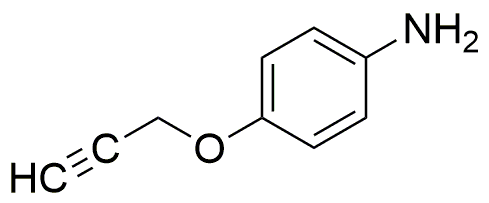4-(2-Propynyloxy)aniline is widely utilized in research focused on:
- Pharmaceutical Development: This compound serves as a key intermediate in the synthesis of various pharmaceuticals, particularly those targeting neurological disorders, enhancing drug efficacy and specificity.
- Polymer Chemistry: It is employed in creating specialty polymers with unique properties, such as improved thermal stability and chemical resistance, making it valuable in the production of high-performance materials.
- Organic Synthesis: As a versatile building block, it facilitates the synthesis of complex organic molecules, streamlining processes in both academic and industrial laboratories.
- Agrochemical Formulations: The compound finds applications in the development of agrochemicals, contributing to more effective pest control solutions while minimizing environmental impact.
- Material Science: Its unique chemical structure allows for the modification of surfaces and coatings, enhancing adhesion and durability in a variety of industrial applications.
General Information
Properties
Safety and Regulations
Applications
4-(2-Propynyloxy)aniline is widely utilized in research focused on:
- Pharmaceutical Development: This compound serves as a key intermediate in the synthesis of various pharmaceuticals, particularly those targeting neurological disorders, enhancing drug efficacy and specificity.
- Polymer Chemistry: It is employed in creating specialty polymers with unique properties, such as improved thermal stability and chemical resistance, making it valuable in the production of high-performance materials.
- Organic Synthesis: As a versatile building block, it facilitates the synthesis of complex organic molecules, streamlining processes in both academic and industrial laboratories.
- Agrochemical Formulations: The compound finds applications in the development of agrochemicals, contributing to more effective pest control solutions while minimizing environmental impact.
- Material Science: Its unique chemical structure allows for the modification of surfaces and coatings, enhancing adhesion and durability in a variety of industrial applications.
Documents
Safety Data Sheets (SDS)
The SDS provides comprehensive safety information on handling, storage, and disposal of the product.
Product Specification (PS)
The PS provides a comprehensive breakdown of the product’s properties, including chemical composition, physical state, purity, and storage requirements. It also details acceptable quality ranges and the product's intended applications.
Certificates of Analysis (COA)
Search for Certificates of Analysis (COA) by entering the products Lot Number. Lot and Batch Numbers can be found on a product’s label following the words ‘Lot’ or ‘Batch’.
*Catalog Number
*Lot Number
Certificates Of Origin (COO)
This COO confirms the country where the product was manufactured, and also details the materials and components used in it and whether it is derived from natural, synthetic, or other specific sources. This certificate may be required for customs, trade, and regulatory compliance.
*Catalog Number
*Lot Number
Safety Data Sheets (SDS)
The SDS provides comprehensive safety information on handling, storage, and disposal of the product.
DownloadProduct Specification (PS)
The PS provides a comprehensive breakdown of the product’s properties, including chemical composition, physical state, purity, and storage requirements. It also details acceptable quality ranges and the product's intended applications.
DownloadCertificates of Analysis (COA)
Search for Certificates of Analysis (COA) by entering the products Lot Number. Lot and Batch Numbers can be found on a product’s label following the words ‘Lot’ or ‘Batch’.
*Catalog Number
*Lot Number
Certificates Of Origin (COO)
This COO confirms the country where the product was manufactured, and also details the materials and components used in it and whether it is derived from natural, synthetic, or other specific sources. This certificate may be required for customs, trade, and regulatory compliance.

